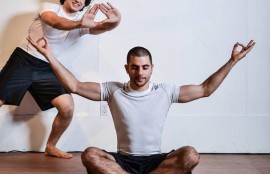 For most of my adult life, exercise was an ordeal. Even mild workouts felt grueling and I left the gym in a fouler mood than when I’d arrived. The very idea of the runner’s high seemed like a cruel joke.
For most of my adult life, exercise was an ordeal. Even mild workouts felt grueling and I left the gym in a fouler mood than when I’d arrived. The very idea of the runner’s high seemed like a cruel joke.
As a science writer investigating the mind-body connection, however, I was surprised to discover many psychological tricks that can turn the pain into pleasure. Putting these simple tips to the test, I now happily burn between 6,000 and 7,000 calories a week with high-intensity interval training, 5km runs and yoga. What was once a torment is now the highlight of my day.
Don’t just take my word for it. Here’s the science behind the five strategies that I found most transformative.
1. Let music be your pacemaker
Choosing the right music for a workout can be as important as picking the right playlist for a party, with ramifications for your enjoyment and your performance.
The benefits are not only found in motivational lyrics – though there’s no doubt that upbeat tracks can infuse you with positive feelings that can help to drown out the sensations of fatigue; when you are lost in the music, you simply forget how hard you are working out.
There are also some physical benefits. Loud, high-octane music also increases our “physiological arousal”, resulting in a faster heart rate that will deliver more oxygen to our muscles. And research by Costas Karageorghis, a professor of sport and exercise physiology at Brunel University London, shows that we naturally synchronise our body’s motion to the underlying rhythm. This reduces any energy-wasting irregularities in our movements and results in more efficient use of our muscles.
If you want to make the most of the pacemaker effect, the tempo of the music must match the type of exercise you are trying to perform. If you are taking a step for every beat, around 170-180bpm (such as Roar by Katy Perry) would be right for a high-intensity run. For energetic cycling, you might want something slower, such as Dangerous by David Guetta ft Sam Martin, at 92bpm.
2. Ignore #fitspo posts
Scrolling through Instagram and TikTok, you’ll come across countless “fitspiration” accounts offering pictures of perfect pecs and tight torsos – a portrait of what might be possible if you only follow the right regime. Such images might seem like a sensible source of motivation, a way of focusing your mind on what you want to achieve. But a study led by Ivanka Prichard at Flinders University, Australia suggests these accounts can lead to a less rewarding workout.
The participants first scrolled through a set of 18 images. Some saw supposedly motivational photos related to fitness, such as before-and-after shots depicting a body transformation. Others saw travel photos of attractive locations. They then took to the treadmill for a 10-minute workout. Far from encouraging the exercisers, the #fitspo images had a negative effect on their mood and increased their rating of “perceived exertion”, so that they found the activity more tiring than the people who had seen the travel snaps. This seemed to be tied to lower body satisfaction – the sight of the fitness gurus had left them feeling less attractive and more concerned about their weight and shape, which put a downer on the whole experience.
3. Reframe the pain
If you are just getting started on a new fitness regime or simply having a bad day, it’s very easy to interpret feelings of fatigue as a sign of failure. The heart thumping hard in your chest, the burning of your lungs, the aches of your limbs – your body seems to be yelling at you to stop exercising. The sensations may even trigger cycles of catastrophic thinking, in which you start to exaggerate your discomfort – “this is awful”, “I can’t take it”, “I’m never going to get fit”.
Psychological science suggests that these thoughts will only amplify your distress – which may, of course, discourage you from continuing your workouts in the future. To avoid this fate, you can practise “cognitive appraisal”. This could involve taking a deliberately dispassionate view that avoids negative interpretation; you might try to passively observe the feelings without judging them. You might even try to see discomfort as a sign of progress – that you are successfully pushing your body to the max.
Studies show that these small changes in mindset can soften the sense of physical distress and the perceived exertion of exercise. Through the mind-body connection, they could even activate a beneficial “expectation effect” – akin to the placebo effect – that alters the physiological response to the exercise. One experiment by Prof Fabrizio Benedetti at the University of Turin found that reframing muscle aches as a positive signal can ramp up the production of the brain’s endogenous cannabinoids and opioids, natural analgesics that could mask the strain.
4. Engage your imagination
Many athletes swear by the power of visualisation. American swimmer Michael Phelps, for example, imagined each event in exquisite detail. “I can see the start, the strokes, the walls, the turns, the finish, the strategy, all of it,” he wrote in his autobiography, No Limits. “Visualising like this is like programming a race in my head, and that programming sometimes seems to make it happen just as I imagined it.”
Sports science seems to back this up: the use of mental imagery can improve the accuracy of our movements, and even our overall strength. Studies show that people who spend a few minutes each day visualising the lifting of heavy weights see bigger strength gains than those who did not practise an imaginary workout. The mental rehearsal is thought to boost the nerve signals sent from the brain to the muscles, increasing the force you can exert when you finally visit the gym. This technique can be especially useful in minimising the loss of strength while recovering from injury.
5. Use temptation-bundling
For many of us, the biggest battle is getting to the gym in the first place when there are so many other activities vying for our time and attention. It’s much harder to summon the willpower to put on your trainers when you might be curled up on the sofa with a trashy novel.
If this is an issue, you can try temptation-bundling, which involves packaging the things you don’t want to do with one of your guilty pleasures. The technique was developed by Prof Katy Milkman at the University of Pennsylvania, who gave people iPods loaded with four addictive audiobooks to enjoy while they worked out. The simple strategy increased their gym attendance by 29% over the following seven weeks.
So dust off your trainers. With each of these strategies nudging you towards your fitness goals, you may find soon find yourself making substantial gains with very little pain.
Original article here






















Sorry, the comment form is closed at this time.